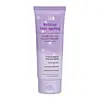What's inside
What's inside
 Key Ingredients
Key Ingredients

 Benefits
Benefits

 Concerns
Concerns

 Ingredients Side-by-side
Ingredients Side-by-side

Water
Skin ConditioningMyristic Acid
CleansingGlycerin
HumectantPalmitic Acid
EmollientPotassium Hydroxide
BufferingLauric Acid
CleansingPolyglyceryl-4 Stearate
EmulsifyingSorbitol
HumectantStearic Acid
CleansingCocamidopropyl Betaine
CleansingGlycol Distearate
EmollientButylene Glycol
HumectantPolyquaternium-7
Phenoxyethanol
PreservativeParfum
MaskingAcrylates Copolymer
Cetearyl Alcohol
EmollientSodium Chloride
MaskingSodium Hydroxide
Buffering3-O-Ethyl Ascorbic Acid
Skin ConditioningNiacinamide
SmoothingSodium Hyaluronate
HumectantTocopheryl Acetate
AntioxidantEthylhexylglycerin
Skin ConditioningTetrasodium EDTA
Polysorbate 20
EmulsifyingRetinol
Skin ConditioningSodium Benzoate
Masking1,2-Hexanediol
Skin ConditioningNigella Sativa Seed Extract
PerfumingBHT
AntioxidantMicrocitrus Australasica Fruit Extract
BHA
AntioxidantSaccharomyces/Xylinum/Black Tea Ferment
Skin ConditioningWater, Myristic Acid, Glycerin, Palmitic Acid, Potassium Hydroxide, Lauric Acid, Polyglyceryl-4 Stearate, Sorbitol, Stearic Acid, Cocamidopropyl Betaine, Glycol Distearate, Butylene Glycol, Polyquaternium-7, Phenoxyethanol, Parfum, Acrylates Copolymer, Cetearyl Alcohol, Sodium Chloride, Sodium Hydroxide, 3-O-Ethyl Ascorbic Acid, Niacinamide, Sodium Hyaluronate, Tocopheryl Acetate, Ethylhexylglycerin, Tetrasodium EDTA, Polysorbate 20, Retinol, Sodium Benzoate, 1,2-Hexanediol, Nigella Sativa Seed Extract, BHT, Microcitrus Australasica Fruit Extract, BHA, Saccharomyces/Xylinum/Black Tea Ferment
Water
Skin ConditioningPropanediol
SolventGlycerin
HumectantAvena Sativa Kernel Extract
AbrasiveSqualane
EmollientBetaine
HumectantGluconolactone
Skin ConditioningSalicylic Acid
MaskingPEG-6 Caprylic/Capric Glycerides
EmulsifyingSodium Lauroyl Oat Amino Acids
CleansingPanthenol
Skin ConditioningZinc PCA
HumectantAllantoin
Skin ConditioningAlpha-Glucan Oligosaccharide
CleansingXylitol
HumectantCoco-Glucoside
CleansingAloe Barbadensis Leaf Extract
EmollientLaminaria Ochroleuca Extract
Skin ConditioningAscophyllum Nodosum Extract
Skin ConditioningPhenoxyethanol
PreservativeCetyl Alcohol
EmollientStearyl Alcohol
EmollientEthylhexylglycerin
Skin ConditioningSodium Benzoate
MaskingCitric Acid
BufferingDehydroacetic Acid
PreservativeTrisodium Ethylenediamine Disuccinate
Tocopherol
AntioxidantWater, Propanediol, Glycerin, Avena Sativa Kernel Extract, Squalane, Betaine, Gluconolactone, Salicylic Acid, PEG-6 Caprylic/Capric Glycerides, Sodium Lauroyl Oat Amino Acids, Panthenol, Zinc PCA, Allantoin, Alpha-Glucan Oligosaccharide, Xylitol, Coco-Glucoside, Aloe Barbadensis Leaf Extract, Laminaria Ochroleuca Extract, Ascophyllum Nodosum Extract, Phenoxyethanol, Cetyl Alcohol, Stearyl Alcohol, Ethylhexylglycerin, Sodium Benzoate, Citric Acid, Dehydroacetic Acid, Trisodium Ethylenediamine Disuccinate, Tocopherol
 Reviews
Reviews

Ingredients Explained
These ingredients are found in both products.
Ingredients higher up in an ingredient list are typically present in a larger amount.
Ethylhexylglycerin (we can't pronounce this either) is commonly used as a preservative and skin softener. It is derived from glyceryl.
You might see Ethylhexylglycerin often paired with other preservatives such as phenoxyethanol. Ethylhexylglycerin has been found to increase the effectiveness of these other preservatives.
Glycerin is already naturally found in your skin. It helps moisturize and protect your skin.
A study from 2016 found glycerin to be more effective as a humectant than AHAs and hyaluronic acid.
As a humectant, it helps the skin stay hydrated by pulling moisture to your skin. The low molecular weight of glycerin allows it to pull moisture into the deeper layers of your skin.
Hydrated skin improves your skin barrier; Your skin barrier helps protect against irritants and bacteria.
Glycerin has also been found to have antimicrobial and antiviral properties. Due to these properties, glycerin is often used in wound and burn treatments.
In cosmetics, glycerin is usually derived from plants such as soybean or palm. However, it can also be sourced from animals, such as tallow or animal fat.
This ingredient is organic, colorless, odorless, and non-toxic.
Glycerin is the name for this ingredient in American English. British English uses Glycerol/Glycerine.
Learn more about GlycerinPhenoxyethanol is a preservative that has germicide, antimicrobial, and aromatic properties. Studies show that phenoxyethanol can prevent microbial growth. By itself, it has a scent that is similar to that of a rose.
It's often used in formulations along with Caprylyl Glycol to preserve the shelf life of products.
Sodium Benzoate is a preservative. It's used in both cosmetic and food products to inhibit the growth of mold and bacteria. It is typically produced synthetically.
Both the US FDA and EU Health Committee have approved the use of sodium benzoate. In the US, levels of 0.1% (of the total product) are allowed.
Sodium benzoate works as a preservative by inhibiting the growth of bacteria inside of cells. It prevents the cell from fermenting a type of sugar using an enzyme called phosphofructokinase.
It is the salt of benzoic acid. Foods containing sodium benzoate include soda, salad dressings, condiments, fruit juices, wines, and snack foods.
Studies for using ascorbic acid and sodium benzoate in cosmetics are lacking, especially in skincare routines with multiple steps.
We always recommend speaking with a professional, such as a dermatologist, if you have any concerns.
Learn more about Sodium BenzoateWater. It's the most common cosmetic ingredient of all. You'll usually see it at the top of ingredient lists, meaning that it makes up the largest part of the product.
So why is it so popular? Water most often acts as a solvent - this means that it helps dissolve other ingredients into the formulation.
You'll also recognize water as that liquid we all need to stay alive. If you see this, drink a glass of water. Stay hydrated!
Learn more about Water